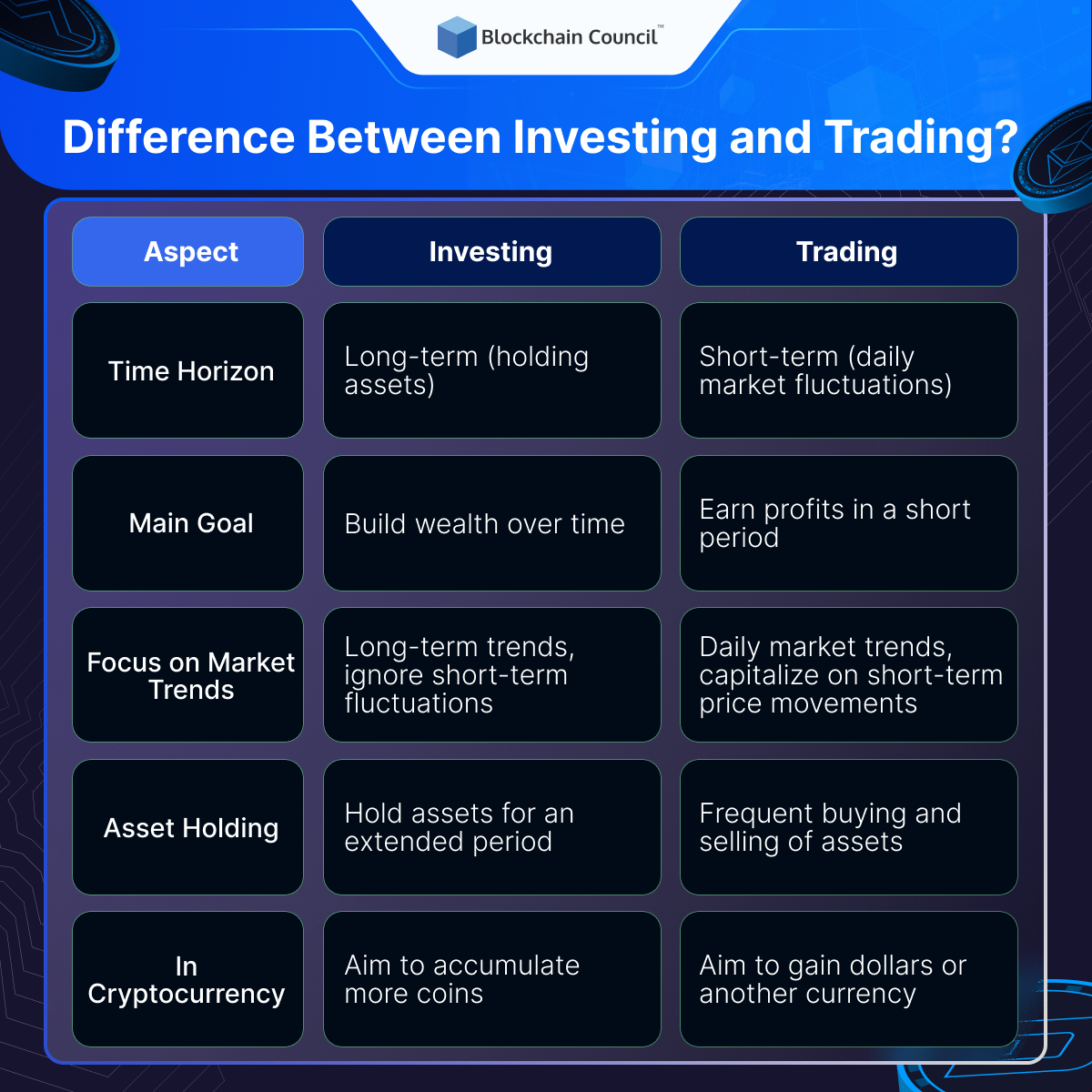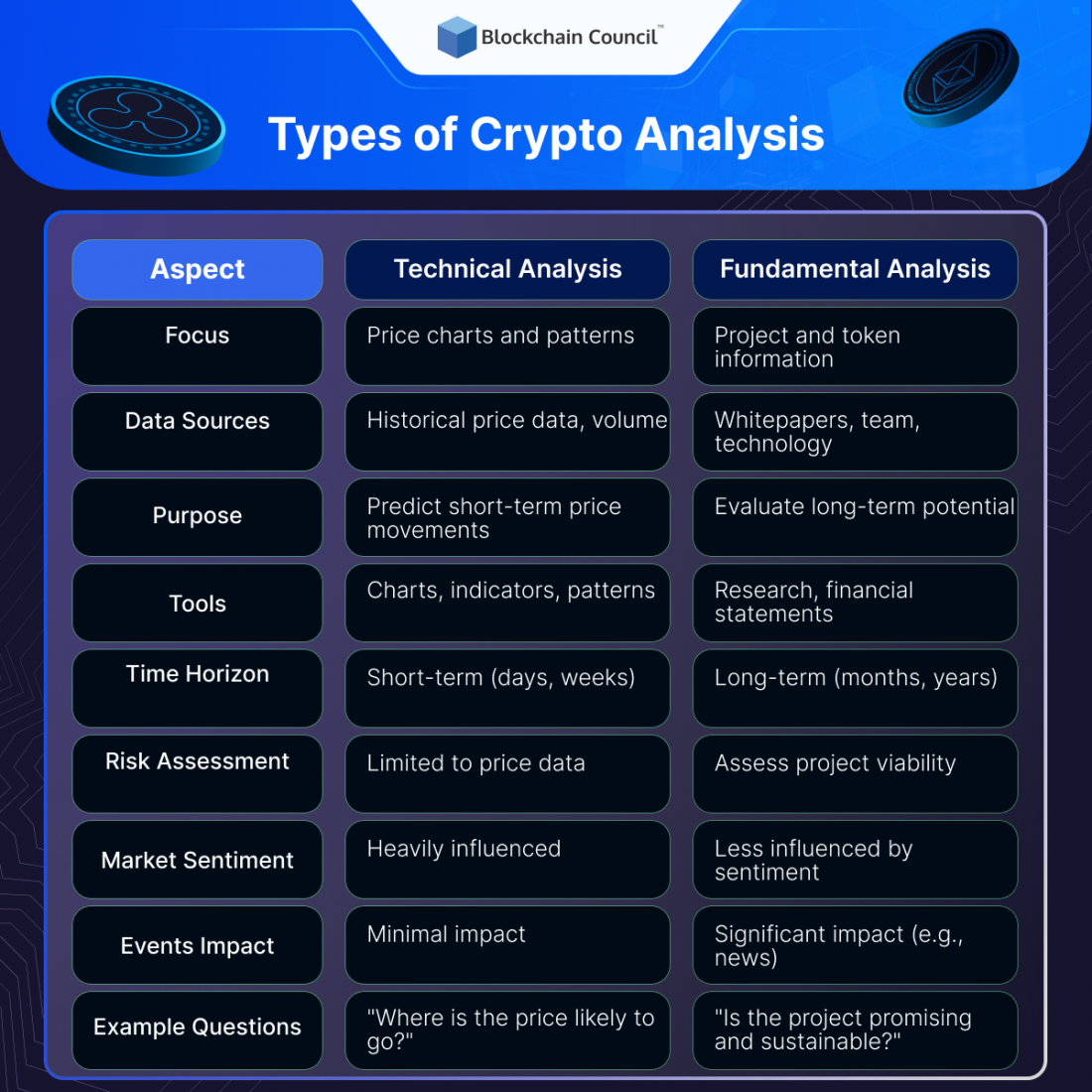
- Ayushi Abrol
- August 23, 2024
What is Cryptocurrency Trading?
Before getting directly to cryptocurrency trading, let us understand the meaning of trading. Trading can be defined as the economical concept of buying and selling assets. The assets can be goods and services which are being exchanged between the trading parties. Here we are talking about the financial markets where trading of financial instruments takes place. These can be stocks, currency, cryptocurrency, margin products, etc. Trading is usually considered short-term; however, this concept is misled by many. Furthermore, we will be discussing types of trading, namely day trading, swing trading, and trend trading, in detail later.
Cryptocurrency trading involves buying and selling cryptocurrency by using a crypto trading platform or exchange. Some of the most popular cryptocurrency trading platforms are Coinbase, Binance, CoinDCX, etc. The idea behind cryptocurrency trading is to achieve profitable outcomes over a certain period of time. Trading differs from investing, and the concept behind it is what we are going to discuss further.
Understanding the Cryptocurrency Market
How the Cryptocurrency Market Works
The cryptocurrency market, a dynamic and innovative financial ecosystem, operates 24/7 worldwide, distinguishing it from traditional stock markets. This digital market is decentralized, meaning it does not rely on central authorities like governments or banks. Instead, it uses blockchain technology, an advanced, distributed ledger that records all transactions across a network of computers. This feature ensures transparency and security, making the cryptocurrency market appealing for traders globally.
Key factors driving this market include supply and demand, investor sentiment, and technological advancements. Unlike traditional markets, cryptocurrencies can be traded directly between individuals through exchanges or peer-to-peer platforms, offering unprecedented accessibility to investors.
Market Trends and Analysis
Staying abreast of market trends is crucial in navigating the volatile landscape of cryptocurrency trading. Trends in this market are influenced by a range of factors, from global economic events to technological breakthroughs in blockchain technology. For instance, the increasing adoption of cryptocurrencies by mainstream financial institutions and the growing interest in decentralized finance (DeFi) are significant trends shaping the market today.
Analyzing these trends requires a keen understanding of market indicators such as trading volume, price fluctuations, and the emergence of new cryptocurrencies. Tools like candlestick charts and moving averages are commonly used for technical analysis, providing insights into market sentiment and potential price movements.
Factors That Affect Cryptocurrency Prices
Supply and Demand:
- Limited supply of certain cryptocurrencies, like Bitcoin, increases value as demand rises.
- Introduction of new coins or tokens can affect the value of existing cryptocurrencies.
Regulatory News and Changes:
- Government regulations, both strict and lenient, can significantly impact cryptocurrency prices.
- Positive regulatory news can boost market confidence, while negative news can lead to declines.
Technological Advancements and Updates:
- Innovations in blockchain technology can increase a cryptocurrency’s value.
- Updates and forks in blockchain protocols can also influence prices.
Market Sentiment:
- Public perception, influenced by media coverage and investor enthusiasm or concern, can drive price fluctuations.
- Social media trends and influencer opinions often sway investor behavior.
Economic Factors:
- Global economic events, such as inflation rates, economic downturns, or currency devaluation, can impact cryptocurrency markets.
- Cryptocurrencies may behave as safe-haven assets during economic instability.
Adoption by Mainstream Finance and Businesses:
- Increasing acceptance of cryptocurrencies by businesses and financial institutions can drive up prices.
- Partnerships with or endorsements from major companies can boost credibility and value.
Investor Activity:
- Large scale buying or selling by major investors (sometimes referred to as ‘whales’) can significantly impact prices.
- Market manipulation tactics can also play a role in price volatility.
Geopolitical Events:
- Political instability or government policies in key countries can influence cryptocurrency markets.
- Sanctions or international trade disputes can affect cross-border cryptocurrency transactions.
Technical Analysis Indicators:
- Traders’ use of various technical indicators can lead to self-fulfilling price movements.
- Commonly used indicators include moving averages, relative strength index (RSI), and others.
Competition Among Cryptocurrencies:
- The launch of new cryptocurrencies or the rise of alternative blockchain projects can impact the value of existing ones.
- Competition in terms of scalability, transaction speeds, and utility can sway investor preferences.
Explore Depositphotos.com for high-quality visuals to enhance your cryptocurrency trading knowledge.
Types of Cryptocurrencies
Overview of Major Cryptocurrencies
In the dynamic world of cryptocurrency, several major players dominate the market. As of 2024, these include:
- Bitcoin (BTC) – Often referred to as the original cryptocurrency, Bitcoin continues to lead the market with its robust blockchain technology and widespread adoption.
- Ethereum (ETH) – Known for its versatile platform that supports smart contracts and decentralized applications (dApps), Ethereum is a key player in the crypto space.
- Binance Coin (BNB) – As the native currency of the Binance Exchange, BNB has gained traction for its utility in reducing transaction fees.
- Cardano (ADA) and Solana (SOL) – These cryptocurrencies are noted for their advanced blockchain platforms offering scalability and faster transaction speeds.
- Stablecoins like Tether (USDT) and USD Coin (USDC) – These coins are pegged to traditional currencies, offering stability in the volatile crypto market.
Emerging or Lesser-Known Cryptocurrencies Worth Watching
With the cryptocurrency landscape continually evolving, several emerging cryptocurrencies show promise in 2023:
- PawFury – A unique blend of gaming and environmental sustainability, leveraging blockchain technology for a greener future.
- Wall Street Memes – A meme coin that integrates popular culture with cryptocurrency, demonstrating the increasing overlap between entertainment and digital currency.
- yPredict – This AI-powered platform predicts crypto prices, illustrating the growing convergence of AI and blockchain technology.
- Ecoterra – Focused on sustainability, Ecoterra rewards recycling efforts with its native tokens, highlighting the trend towards environmentally conscious cryptocurrencies.
Current Trends Influencing Cryptocurrency Types
As you explore these cryptocurrencies, it’s essential to understand the broader trends shaping the market in 2023:
- Slow Market Recovery: The crypto market is experiencing a gradual recovery, with established coins like Bitcoin and Ethereum expected to maintain stability despite market volatility.
- Increased Regulation: New legislations are set to impact the crypto space, potentially leading to safer investment environments.
- Rise of CBDCs and Enterprise Blockchain: Central Bank Digital Currencies (CBDCs) are gaining traction, and enterprises are increasingly adopting blockchain technology for data security.
- AI Integration: AI is becoming a significant part of blockchain technology, offering innovative solutions like AI-powered NFTs and enhanced security against fraud.
- Interoperability and DAOs: The trend towards interoperable blockchains and the rise of Decentralized Autonomous Organizations (DAOs) are reshaping how we interact with cryptocurrencies.
How to Trade Cryptocurrencies?
For beginners, it’s imperative to follow the proper steps for cryptocurrency trading. Here are a few steps which you can take and begin your trading journey.
Step 1: Look For Cryptocurrency Exchange
As a beginner, the very first step is to look for the best cryptocurrency exchanges. Some of the most popular ones are:
- Binance
- Coinbase
- Kraken
- CoinDCX
- Gemini and many more
You need to make a crypto brokerage account. It will be similar to opening a stock brokerage account. Also, make sure to provide the necessary information required.
Step 2: Fund Your Account
As soon as you create your account in any of the Cryptocurrency exchanges, the next step is to fund your account. Using debit cards and wire transfers. You can easily add money to your digital wallet. Also, wire transfer is one of the cheapest options for funding your account. Crypto exchanges like Coinbase and Gemini provide wire transfers for free.
Step 3: Choose your Cryptocurrency
There are many cryptocurrencies in the market, but most expert traders go for bitcoin and ethereum. The reason is these cryptocurrencies are more predictable than other small coins. However, altcoins have also seen a rise of about 1000% in just a month which can be considered as a good option while trading.
Step 4: Choose a Strategy
Picking up a trading strategy is a critical step in cryptocurrency trading. Therefore, by utilizing the trading indicators with the correct fundamental and technical analysis, you can achieve high profits in cryptocurrency trading. However, if you are a beginner, pursuing a cryptocurrency trading course and becoming an expert is recommended.
Step 5: Securely Store your Cryptocurrency
Lastly, it is essential to store your crypto in a safe place. For that, you can choose a digital wallet, and it can be software or hardware. Cryptocurrency wattles are highly recommended for storing your digital assets. Cryptocurrency security can be achieved more with hardware wallets.
Difference Between Investing and Trading?
Investing is quite different from trading; trading has the concept of gaining profit within a certain time period, whereas investment works when you hold the assets for the long term. While making any investment, we need to look for long-term trends and turn a blind eye to short-term fluctuations in the market. In cryptocurrency investment, the main goal is to get more coins. For instance, if you have purchased four bitcoins at a certain price, after a few years, the entire invested value of your asset will increase in proportional to the coin price.
On the other hand, trading is concerned with short-time fluctuations, and thus it is essential to understand the daily market while trading. The main goal is to earn dollars or any other currency. Experts recommend understanding the market trends and short-term price trends if you want to excel in cryptocurrency trading. It is more like buying in low and selling at high prices, then the trends turn out to be in your favor. In cryptocurrency trading, you will need to drop coins very often in order to gain maximum profit.
Structure of a Trade
The structure of trade combines the buyer and seller. In trading, one will gain, and the other will lose. In simple words, if the person is gaining profit in selling, the other one will have potentially low benefit. When you step into cryptocurrency trading, keep the fact clear which is understanding the market trends to prevent yourself from getting high losses. As the crypto market is volatile, it is always recommended to invest the amount you can afford to lose, and if you are a newbie, you must consult an expert. Certified Cryptocurrency Trader is an expert in managing the buying and selling of cryptocurrency by considering market trends. Also, they are aware of the trade structure and execute the trade accordingly. If you are also interested in exploring crypto trading then you must consider the factors affecting the market trends. For instance, when more people are buying any particular order, the price generally goes up. In contrast, when people are selling more than buying, the price tends to drop.
To understand the market trends better, let us understand the different types of trading strategies.
Basics of Cryptocurrency Trading
Understanding Buy/Sell Orders
- Definition: Buy orders are instructions to purchase a cryptocurrency at a specific price, while sell orders are instructions to sell a cryptocurrency when it reaches a certain price.
- Market Orders vs. Limit Orders: Market orders are executed immediately at the current market price, whereas limit orders are set to execute at a specific price, offering more control but no guarantee of execution.
- Importance of Order Types: Understanding these orders is crucial for effective trading, allowing you to manage your investments according to your strategy and risk tolerance.
Risk Management and Diversification
- Start Small: Begin with an amount you are comfortable holding long-term and that you don’t immediately need, to minimize risk as you gain experience.
- Diversification: Investing in multiple cryptocurrencies can reduce overall risk and potentially increase returns. Regularly monitor your portfolio to align it with your goals.
- Chart Reading Skills: Develop the ability to interpret charts and data to make informed decisions and manage risks effectively.
Understanding Fees and Costs Associated with Trading
- Spot Fees: Charged for immediate transactions, typically a percentage of the trade value. Selecting an exchange with low or no spot fees is crucial for frequent traders.
- Maker and Taker Fees: Maker fees are charged for adding liquidity to the market, usually less than taker fees, which are charged for taking liquidity away.
- Spreads: The difference between the buying and selling price of a cryptocurrency, affecting the actual cost of transactions.
- Additional Fees: Be aware of other costs such as credit card fees, app trading fees, and miner fees for transaction verification.
Different Types of Trading Strategies
There are four active trading strategies that usually get implemented across the market. An active trading strategy can be defined as an act of securely buying and selling considering the short-term market trends and gaining profit from the market’s volatility. Most experts believe that active trading strategy changes with the long-term strategies where investors buy and hold the assets.
The four strategies are Scalping, day trading, swing trading, and position trading, which are explained below:
-
Scalping
Scalping is the shortest-term trading strategy followed by many experts to gain instant profits. In this type of trading, people hold the coins for a few minutes or seconds. However, the gain is not as much as other trading strategies. The purpose of scalping is to achieve small profits which are accumulated throughout the day. The optimum time to execute the trade is when the market is super busy, then the chances of getting profit are maximum. The certified cryptocurrency traders and experts actively practice scalp trading to profit from the small price movements.
-
Day Trading
This type of cryptocurrency trading involves the holding of assets for a day. Day Trading is also known as “intraday trading,” where traders enter and exit the position within the same day. In this type of trading, you need to consider basic technical analysis using technical indicators that can help you determine current market conditions and identify the trends. Implementing this type of trading also offers small profits; however, it keeps you away from overnight market volatility. Day trading is usually held for few hours.
-
Swing Trading
In the Swing trading strategy, people hold the position for several days or few weeks. This trading type follows short to intermediate-term trends ranging typically between 1-30 days. The person who is not active on a daily basis and dedicated their time to their jobs can implement this type of trading strategy. Here, you do not need to worry about the daily ups and downs because in swing trading you will not hold the cryptocurrency for just a day. However, keeping up with the trend and checking the daily analysis will help you gain the optimum profits.
-
Position Trading
In this type of trading strategy, you need to focus on the long-term price shifts. In order to gain maximum profit, major price shifts are considered by the trading experts. Position trading is also known as “trend trading”, as traders tend to hold the position for more extended periods of time. Also, analyzing weekly and monthly price charts can benefit you in evaluating the market trends. While implementing this type of trading strategy, traders are not worried about minor fluctuations in the price. In fact, they are only concerned about the major market trends and follow up accordingly.
-
Spot Trading
Spot trading is the simplest form of crypto trading. It involves buying and selling cryptocurrencies at the current market price. In this method, you own the actual cryptocurrencies and store them in your wallet. Spot trading is often done on centralized exchanges like Coinbase and Binance. It’s commonly used by long-term investors who want to hold cryptocurrencies rather than actively trade them. Spot trading is considered less risky because it doesn’t involve borrowing money or leverage, and you only invest what you can afford to lose.
-
Margin Trading
Margin trading allows traders to borrow funds from a crypto exchange to amplify their trading positions. This means you can control a larger amount of cryptocurrency than your initial capital. However, it also increases the potential for both profits and losses. Traders need to repay the borrowed funds, and if a trade goes against them, they could end up with losses greater than their initial investment. Margin trading is suitable for experienced traders who understand the risks involved and can effectively manage their positions.
-
Futures Trading
Futures trading is a way to speculate on the future price of a cryptocurrency without owning the actual asset. It is typically conducted on decentralized exchanges like Deribit. Traders enter into contracts that oblige them to buy or sell a cryptocurrency at a predetermined price on a specified future date. Futures trading can offer the opportunity to profit from both rising and falling markets, but it’s more complex and riskier than spot trading. It’s often favored by professional traders and investors comfortable with leverage and derivatives.
-
Options Trading
Options trading involves buying or selling the right, but not the obligation, to buy or sell a cryptocurrency at a specified price on or before a particular date. Options are used for various purposes, including hedging existing crypto positions and speculating on price movements. This trading method provides flexibility and can be less risky than other approaches since traders only pay the premium and aren’t obligated to execute the trade. Options trading is typically conducted on decentralized exchanges like Deribit.
So as per your requirement and availability, you can choose any of the cryptocurrency trading strategies.
Types of Crypto Analysis
Technical Analysis:
Technical analysis is a method of evaluating and predicting future price movements of cryptocurrencies based on the analysis of historical price and trading volume data. It relies on the following principles and tools:
- Price Charts: Technical analysts use price charts, typically in the form of candlestick or line charts, to visualize the historical price movements of a cryptocurrency over time.
- Patterns: They look for specific patterns or formations on the charts, such as head and shoulders, double tops, and flags. These patterns are believed to provide insights into future price trends.
- Indicators: Various technical indicators are employed, including Moving Averages, Relative Strength Index (RSI), and MACD. These indicators help traders identify trends, momentum, and potential entry or exit points in the market.
- Support and Resistance: Technical analysis often involves identifying support levels (where buying interest tends to occur) and resistance levels (where selling pressure is encountered). Traders use these levels to make decisions about stop-loss and take-profit orders.
- Volume Analysis: The trading volume, which represents the number of coins traded within a given time frame, is considered. Increased trading volume can validate a trend, while declining volume may signal a reversal.
- Trends: Technical analysts follow the concept of trends, which can be classified as bullish (rising prices), bearish (falling prices), or sideways (stable prices). They aim to ride trends and avoid counter-trend trading.
Fundamental Analysis:
Fundamental analysis is a method of evaluating the intrinsic value and long-term potential of a cryptocurrency by assessing factors beyond its price and volume data. It encompasses the following aspects:
- Team and Development: Fundamental analysis involves scrutinizing the team behind a cryptocurrency project. The experience, expertise, and track record of the developers, founders, and advisors can influence the project’s success.
- Technology and Use Cases: It examines the underlying technology of the cryptocurrency and its practical applications. For Blockchain projects, this includes assessing factors like scalability, security, and the real-world problems the technology aims to solve.
- Market Demand: Fundamental analysis considers whether there is actual demand for the cryptocurrency. This is assessed by evaluating factors such as user adoption, partnerships, and the size of the potential market the cryptocurrency addresses.
- Regulatory Environment: The regulatory landscape is taken into account. Understanding how governments and regulatory bodies view cryptocurrencies is crucial, as regulatory changes can have a significant impact on the market.
- Tokenomics: This involves an examination of the cryptocurrency’s token economics, which includes aspects like token supply, distribution, and inflation rate. Factors like scarcity and controlled inflation can affect the value of the token.
Fundamental analysis aims to determine whether a cryptocurrency has a sustainable and valuable future, while technical analysis focuses on identifying short-term price trends and potential entry and exit points in the market. Traders and investors often use both methods in combination to make informed decisions regarding their cryptocurrency investments.
Advanced Trading Strategies
Leveraged and Margin Trading
- Concept: Leverage trading in cryptocurrency allows traders to borrow funds to increase their trading position beyond what would be available from their cash balance alone. This can amplify both profits and losses.
- Margin Trading: Involves borrowing funds for trading. For instance, with a $100 account balance, a trader could trade up to $1,000 worth of Bitcoin using leverage, potentially doubling their investment with a 20% price increase.
- Platforms: Major exchanges like FTX, Bybit, and Binance offer margin trading options with varying fees and leverage ratios.
Futures and Options
Futures and options in cryptocurrency are advanced financial instruments that provide traders with ways to speculate, hedge risks, and manage their trading positions in the volatile crypto market. Here’s an in-depth look at these instruments:
Bitcoin Futures
- Basics: Bitcoin futures are standardized contracts that obligate parties to transact Bitcoin at predetermined terms at a future date. These contracts are essential tools for traders and investors to navigate the crypto market.
- Open Interest and Market Activity: Open interest in futures contracts, like purchasing Bitcoin at a specified price on a future date, is a key metric. An increase in open interest indicates a growing number of contracts being held, which could suggest more traders betting on the price reaching a certain level by the contract’s expiration.
Margins and Leverage:
- Role in Futures Trading: Margins, provided as a security deposit, play a critical role in futures trading, enabling traders to leverage their positions. This amplifies both potential gains and risks.
Bitcoin Options
- Fundamentals: Bitcoin options are contracts giving the buyer the right, but not the obligation, to buy or sell Bitcoin at a pre-agreed price and date. They are versatile tools for speculation and risk management.
- Call and Put Options: Call options give the right to buy Bitcoin at a set price within a specific timeframe, while put options confer the right to sell.
- Market Volatility and Open Interest: The Bitcoin options market has seen significant growth, with total volume increasing by 133% in 2023. This indicates sustained interest from both institutional and retail sectors. Open interest levels have remained stable despite market downturns.
- Impact of Market Events: Events like the Bitcoin flash crash can dramatically re-price options markets, affecting implied volatility and short-term holder supply. Such events underscore the risks inherent in these markets.
- Effective Approaches: Key strategies include setting stop-losses, using lower leverage, and diversifying with options to mitigate potential losses in the volatile market.
Trading Cryptocurrency Options
Trading Process:
- Choosing an Exchange: The first step is selecting a reputable exchange that offers options trading, with a robust interface and a solid track record for security and regulatory compliance.
- Account Setup and Funding: After choosing an exchange, traders need to create an account and fund it, which might involve transferring cryptocurrency or using traditional funding methods.
- Understanding Option Contracts: Familiarization with the terms and mechanics of options contracts, including types of options (American vs. European), expiration dates, and strike prices, is crucial before trading.
Use Cases:
- Hedging and Speculating: Cryptocurrency options allow traders to hedge against market volatility, speculate on price movements, and strategize with sophisticated market plays. For instance, purchasing a call option on Bitcoin when anticipating a price increase can yield gains if the price rises beyond the strike price before expiration.
- Managing Risks: Options trading requires strategic planning and thorough market understanding. Due to the complex nature and significant risks involved, traders are advised to proceed with caution and seek financial advice if necessary.
DeFi in Crypto Trading
Decentralized Finance (DeFi) is transforming the landscape of financial services through its innovative use of blockchain technology and smart contracts. Here’s a detailed exploration of DeFi and its impact on trading:
Overview of Decentralized Finance (DeFi)
- Definition: DeFi is a blockchain-based financial ecosystem designed to decentralize and democratize access to financial services, eliminating the need for traditional intermediaries like banks and brokerage firms.
- Key Industries Impacted: DeFi has the potential to revolutionize sectors such as banking, insurance, real estate, supply chain, and gaming by offering accessible, cost-effective, and efficient solutions.
Key Components of DeFi
- Smart Contracts: These are self-executing contracts with the terms of the agreement embedded in code. They play a critical role in automating transactions and ensuring transparent and trustless interactions within the DeFi ecosystem.
- Decentralized Exchanges (DEXs): Platforms like Uniswap and SushiSwap facilitate peer-to-peer trading of digital assets without central authorities, offering increased security and reduced fees.
- Stablecoins: Digital tokens pegged to stable assets, they provide a less volatile medium of exchange within the DeFi space.
- Lending and Borrowing Platforms: These platforms enable users to lend or borrow digital assets in a decentralized manner, removing the need for traditional financial institutions.
Risks and Challenges
- Smart Contract Vulnerabilities: Poorly coded or unaudited smart contracts can pose significant security risks, potentially leading to the loss of user funds.
- Impermanent Loss: This is a risk specific to liquidity providers in DEXs, where fluctuating token prices can lead to a temporary loss in value.
- Regulatory Uncertainty: The evolving nature of DeFi has left regulators playing catch-up, creating an unpredictable environment that may affect the viability of certain platforms.
Future Prospects of DeFi
- Integration with Traditional Finance: Collaboration between DeFi platforms and traditional financial institutions could lead to the development of hybrid financial products, combining the strengths of both systems.
- Scalability and Interoperability: Innovations like Layer 2 solutions and cross-chain protocols are crucial for the growth of DeFi, enabling more efficient transaction handling and communication across different blockchain networks.
- Enhanced Security Measures: Ongoing improvements in security, including smart contract audits and the implementation of privacy-enhancing technologies, are essential for the future of DeFi.
Crypto Trading and the Need of Education
Staying Informed and Continuing Education
To remain updated in the ever-evolving world of cryptocurrency, following the latest trends is essential. As of 2023, some key trends in the crypto market include:
- Slow Recovery of the Market: Post-2022’s challenging period, the crypto market is expected to recover slowly, with blue-chip coins like Ethereum and Bitcoin likely to maintain their prices.
- Regulation: Increasing legislation, such as the EU’s MiCA act and the US’s STABLE Act, will significantly impact the crypto space.
- Growth in CBDCs (Central Bank Digital Currencies): A notable rise in CBDCs is expected, with significant global banks likely to issue these in the near future.
- Blockchain in Government and Enterprises: Governments and large enterprises are increasingly adopting blockchain technology for various applications, including CBDCs and data security.
- AI in Blockchain: Artificial Intelligence (AI) is becoming a crucial part of blockchain, especially in enhancing security and fighting fraud.
- NFTs and Crypto in Gaming: NFTs are finding new applications in gaming, and the Web3 gaming sector is poised for growth in 2023.
Online Certifications
If you’re thinking about getting into crypto trading and setting up your own crypto trading operation, getting certified by the Blockchain Council can really help you succeed. These certifications give you a solid understanding of Bitcoin and Blockchain technology, which is crucial in the world of cryptocurrency.
These certification programs not only teach you the theory but also get into the nitty-gritty details of Bitcoin trading. They cover things like choosing and optimizing your crypto trading strategy, and setting up strong security measures. Knowing these technical aspects is key to running a Bitcoin trading operation smoothly.
They also focus on managing risks in the volatile crypto market. Understanding potential risks and learning how to deal with them is important to protect your investment and make sure your Bitcoin trading business lasts.
Apart from gaining knowledge, these programs help you connect with others in the crypto community. Building a network with professionals can give you ongoing support, valuable insights, and potential partnerships, making you better in the crypto business.
Having a cryptocurrency certification adds credibility to your skills. It’s useful when you’re looking for partnerships, investments, or trying to gain trust from clients and stakeholders. It shows that you’re committed to being professional and excellent in the crypto industry. Further, it will help your professional growth in the field of cryptocurrency trading. Consider these top crypto certifications as you get into the crypto trading world:
Joining Communities and Forums
Engaging with online communities and forums is another great way to stay informed and continue your education in cryptocurrency. Some recommended platforms for beginners include:
- BitcoinTalk: A pioneer forum in the cryptocurrency world, offering diverse discussions ranging from technical support to project development.
- r/Bitcoin: A popular subreddit for Bitcoin enthusiasts, providing a platform for detailed discussions and learning resources.
- r/CryptoCurrency: Another subreddit with over 2 million subscribers, focusing on broader cryptocurrency topics.
- Other Forums and Social Media Platforms: Platforms like Telegram, Discord, and Slack host vibrant crypto communities. For more tech-savvy individuals, Bitcoin StackExchange and GitHub repositories offer in-depth discussions and contributions.
These resources and platforms offer a wealth of information and a supportive community for both beginners and seasoned traders, ensuring you stay at the forefront of the cryptocurrency world.
- Certified Cryptocurrency Auditor™ (CCA): This certification is tailored for those interested in auditing blockchain-based cryptocurrencies. It focuses on the core concepts of auditing in the cryptocurrency and blockchain domain. The curriculum includes in-depth knowledge of blockchain technology, the ability to audit cryptocurrencies, and insights on various cryptocurrency scams and frauds. This certification is ideal for individuals specializing in cryptocurrency and blockchain forensics, providing them with the skills to perform blockchain forensics and track the exchange of cryptocurrencies.
- Certified Cryptocurrency Expert™ (CCE): This advanced level certification is designed to provide expertise on cryptocurrencies and digital assets. It covers the fundamentals of blockchain technology and the technological infrastructure powering it. The course is aimed at individuals with little to no prior knowledge of blockchain technology. It covers strategies for optimal trading decisions in the crypto market and the basics of cryptocurrency trading from scratch.
- Certified Bitcoin Expert™: This certification focuses on the practical and theoretical aspects of Bitcoin. It covers a wide range of topics, from the introduction to bitcoin and blockchain to the regulations around bitcoin, its units, and how to buy bitcoins. This certification is for individuals looking to build blockchain-based applications and re-invent traditional businesses using bitcoin. It’s suitable for various roles, including Bitcoin consultants, miners, and traders.
- Certified Cryptocurrency Trader™ (CCT): This certification is designed for those interested in cryptocurrency trading. It provides in-depth practical knowledge of how trading in the cryptocurrency market works. The course covers analytical skills necessary for trading, as cryptocurrencies are riskier and more volatile than traditional financial instruments. This certification is ideal for finance professionals, entrepreneurs, and investors seeking to deepen their knowledge of cryptocurrency and blockchain technology. It prepares individuals to execute profitable trades, analyze market trends, and manage investment portfolios in the cryptocurrency market.
Artificial Intelligence in Crypto Trading
Artificial Intelligence (AI) is revolutionizing the landscape of cryptocurrency trading. By integrating cutting-edge technology with traditional trading methods, AI is empowering traders to make more informed and effective decisions. This article delves into the dynamic role of AI in crypto trading, highlighting its impact and the concept of AI crypto coins.
AI’s Role in Enhancing Trading Strategies
- Automated Trading Bots: AI-driven trading bots have become a game-changer in the crypto trading sphere. These bots, designed to execute trades automatically based on pre-set criteria, are particularly beneficial for beginners. They allow new traders to implement profitable strategies without needing deep market knowledge. Moreover, advanced algorithms enable these bots to handle over 86% of crypto trading volume, offering high efficiency and reducing manual effort.
- Algorithmic Pattern Analysis: AI algorithms are adept at analyzing historical market data to uncover patterns that might elude human traders. By identifying these patterns, AI can predict future market movements, providing traders with precise entry and exit points. This capability is crucial for strategic planning and risk management.
- Market Insights and Trend Prediction: AI tools, equipped with market screeners and Natural Language Processing (NLP), can rapidly deliver valuable market insights. They analyze vast amounts of technical data and social media sentiment to identify early market trends, aiding traders in spotting market tops and bottoms. These insights are invaluable for both short-term trading and long-term investment strategies.
Potential Risks and Challenges
AI trading platforms, while beneficial, come with their own set of risks. Lack of experience among community traders, programming errors, over-reliance on technology, and potential market manipulation by platform owners are some challenges that traders should be aware of. It’s crucial for traders to approach AI trading with caution and complement it with their own research and analysis.
Concept of AI Crypto Coins
-
- Definition and Scope: AI crypto coins are digital tokens that power AI-based blockchain projects. These projects, leveraging the versatility of AI, cover a broad spectrum of applications including gaming, Web3 environments, decentralized marketplaces, and tracking solutions.
- Key AI Crypto Projects in 2023:
-
- Launchpad XYZ: An all-in-one Web3 ecosystem that provides crypto wallets, access to new presales, and play-to-earn environments.
- Meme Kombat: A decentralized gaming platform where users can play and wager on meme coin avatars.
- eTukTuk: An automotive project promoting electric vehicle adoption, using its token for transactions at charging stations.
- yPredict: An advanced AI-based trading and research platform offering predictive models and financial insights.
- Cogwise: Provides fast and accurate trading information through its state-of-the-art AI model.
- Other notable projects include Fetch.ai, The Graph, VeChain, SingularityNET, and Render, each bringing unique AI-driven solutions to various industry challenges.
To excel in the rapidly evolving world of AI-driven crypto trading, it’s crucial to have a deep understanding of the underlying technologies and strategies. That’s why we highly recommend exploring our comprehensive AI guide and considering obtaining an AI certification. These resources are tailored to equip you with the necessary skills and knowledge to navigate the complexities of AI in crypto trading effectively. By enhancing your expertise in AI, you can make more informed decisions, stay ahead of market trends, and potentially increase your trading success.
Embrace the opportunity to transform your trading journey with the power of AI learning. Whether you’re a beginner or an experienced trader, these resources are designed to provide valuable insights that align perfectly with the dynamic nature of cryptocurrency trading. Don’t miss out on the chance to be at the forefront of this technological revolution – explore our AI guide and certification program today!
Crypto Trading Tools You Need
TradingView:
- TradingView is a versatile charting and technical analysis tool that allows traders to monitor and analyze multiple cryptocurrency markets concurrently.
- It offers features like real-time data, a wide range of technical indicators, and the ability to backtest trading strategies.
CoinMetrics:
- CoinMetrics serves as a data analysis platform that provides insights into the on-chain activity of cryptocurrencies.
- Traders can use CoinMetrics data to identify trends, assess risks, and make more informed trading decisions.
Chainalysis:
- Chainalysis is a Blockchain intelligence platform that offers insights into the movement of cryptocurrency funds.
- Traders use Chainalysis data to track large transactions (whale activity), identify potential scams, and make well-informed trading choices.
Glassnode:
- Glassnode is a data analytics platform that provides traders with a comprehensive view of the cryptocurrency market.
- It assists traders in tracking market trends, identifying undervalued assets, and making better investment decisions.
Santiment:
- Santiment is a social media analysis platform that offers insights into the sentiment surrounding cryptocurrencies.
- Traders utilize Santiment data to gauge market sentiment, assess risk, and make more informed trading decisions.
IntoTheBlock:
- IntoTheBlock is a data analytics platform that provides insights into the distribution of cryptocurrency holdings.
- Traders use its data to identify support and resistance levels, assess risk, and make well-informed trading decisions.
Dex Aggregators:
- Dex aggregators like Matcha, 1inch, and ParaSwap allow traders to efficiently swap tokens across multiple decentralized exchanges (DEXes) to obtain the best available prices.
Yield Optimizers:
- Yield optimizers, such as Yearn.finance and Convex Finance, help traders maximize the yield on their crypto assets by automatically managing their investments in various DeFi protocols and liquidity pools.
Managing Risks and Emotions in Trading
Importance of Setting Stop-Loss and Take-Profit Points
- Definition and Purpose: Stop-loss orders are vital tools in crypto trading, allowing traders to manage risk and limit potential losses on any given trade. By setting a reasonable stop-loss value, traders can specify when they no longer wish to be exposed to the market, thus controlling the risk factor of their trades.
- Risk Management Strategy: Mastering the skill of setting stop-loss and take-profit levels is a crucial aspect of risk management in crypto trading. These tools help traders to automatically close positions at predetermined price levels, mitigating the impact of unexpected market movements.
- Practical Application: When setting these levels, consider factors like current market volatility and the duration of your position. This helps in making informed decisions that align with your trading strategy and risk tolerance.
Dealing with Volatility in the Crypto Market
- Understanding Volatility: Volatility in the crypto market refers to rapid and significant price changes over short periods. This high volatility, characterized by large price swings, makes the market unpredictable and, at times, risky.
- Market Dynamics: Volatility is influenced by various factors, including market news, technological advancements, and instances of fraud or failure of crypto platforms. Being aware of these factors can help traders navigate the market more effectively.
- Opportunities and Risks: While volatility is often viewed as a risk, it also creates opportunities for profit. Understanding how to measure and react to volatility is essential for successful trading.
Psychological Aspects of Trading and Avoiding Common Pitfalls
- Emotional Triggers: Trading in cryptocurrencies can be emotionally charged due to market unpredictability. Emotions like fear, greed, and the fear of missing out (FOMO) can lead to impulsive decisions, affecting profitability.
- Psychological Strategies: To combat emotional biases, traders should maintain perspective, develop a structured trading plan, stay disciplined, take regular breaks, and practice consistently. Automated strategies can also help in making rational trading choices..
- Behavioral Insights: Understanding the emotional, cognitive, and behavioral aspects influencing trading decisions is crucial. This includes being aware of emotional triggers, decision-making processes, risk tolerance, and overall trading behavior.
Legal and Regulatory Environment
Understanding the Legal Aspects of Cryptocurrency Trading
Cryptocurrency trading operates in a complex and evolving legal framework. In the United States, the regulatory environment is characterized by the involvement of multiple federal institutions, including the Financial Crimes Enforcement Network (FinCEN), the Securities and Exchange Commission (SEC), and the Commodity Futures Trading Commission (CFTC). Each of these regulators plays a specific role, depending on whether a digital asset is considered a money transmitter, a security, or a commodity/derivative.
Significant legislation affecting cryptocurrency includes the Bank Secrecy Act (BSA), amended by the Anti-Money Laundering Act (AMLA) and the USA Patriot Act. These laws establish an anti-money laundering framework applicable to various business models dealing with digital assets. For instance, entities like P2P exchangers, hosted wallet providers, and operators of Convertible Virtual Currency (CVC) kiosks fall under these regulations.
Global Regulatory Landscape for Cryptocurrencies
Globally, the crypto asset industry is moving towards increased regulatory oversight. The European Union is progressing with the new Markets in Crypto-Assets Regulation, while Dubai is establishing the world’s first authority focusing on virtual assets. In the UK, the government plans to regulate cryptoassets as a financial instrument. Although the U.S. is making legislative advances in digital assets, the exact timing remains uncertain.
This global shift towards regulation is evident as over 25 jurisdictions are either implementing or on the verge of introducing regulatory frameworks for digital assets. This trend is expected to gain momentum, providing much-needed clarity and certainty for both traditional financial institutions and crypto-native firms.
Taxation and Compliance
Compliance with existing regulations is paramount for companies dealing with digital currencies. They must adhere to the BSA and register with appropriate federal agencies like FinCEN, SEC, and CFTC, based on the nature of the assets. Additionally, state-level regulations must also be followed.
An essential part of compliance is the implementation of an Anti-Money Laundering (AML) program, proportional to the size and nature of the company. This includes establishing policies, procedures, and internal controls for compliance, independent testing, designating responsible individuals, and ongoing training. Moreover, companies are required to maintain adequate record-keeping and reporting systems, including procedures for suspicious activity reports under the BSA.
Things to Keep in Mind Before Trading Crypto
- Research and Education: Begin by thoroughly understanding cryptocurrencies, blockchain technology, and various trading strategies. Stay updated with the latest news and market trends.
- Risk Management: Only invest what you can afford to lose. Cryptocurrency markets can be highly volatile, so it’s crucial to set stop-loss orders and have a clear exit strategy.
- Diversification: Avoid putting all your funds into a single cryptocurrency. Diversify your portfolio to spread risk by considering different cryptocurrencies and assets.
- Emotional Control: Keep your emotions in check. Fear and greed can lead to impulsive actions and losses. Stick to your trading plan and strategy.
- Security: Protect your cryptocurrencies with secure wallets and strong passwords. Hardware wallets are recommended for long-term storage. Be vigilant about phishing scams.
- Exchange Selection: Choose reputable and secure cryptocurrency exchanges for trading. Conduct thorough research before opening an account.
- Trading Strategies: Develop a clear trading strategy that aligns with your risk tolerance and goals. Understand the type of trading you’re doing, whether it’s day trading, swing trading, or long-term investing.
- Technical Analysis: Utilize technical analysis to identify potential entry and exit points. Familiarize yourself with chart patterns, indicators, and other tools.
- Fundamental Analysis: For long-term investments, assess the fundamentals of the cryptocurrencies you’re interested in, including the team, technology, and use cases. Stay informed about relevant news and developments.
- Timing and Patience: Timing the market perfectly is challenging. Be patient and avoid making impulsive decisions based on short-term price movements.
- Compliance and Taxes: Understand the tax implications of cryptocurrency trading in your country and maintain records of your transactions for tax reporting.
- Scams and Fraud: Be cautious of offers that sound too good to be true, as cryptocurrency is susceptible to scams and fraudulent schemes. Verify the legitimacy of projects and exchanges before investing.
- Community and Networking: Engage with the crypto community, participate in discussions, and seek advice from experienced traders. Networking can provide valuable insights and tips.
- Continuous Learning: Recognize that the crypto market evolves rapidly. Stay open to learning and adapting your strategies to new trends, innovations, and regulatory changes.
- Seek Professional Advice: If unsure about your trading decisions, consider consulting with a financial advisor or professional who understands cryptocurrencies.
Conclusion
We have discussed the basics of cryptocurrency trading, which included trading, the structure of cryptocurrency trading, types of trading strategies, and steps that must be taken to start crypto trading by yourself. If you are interested in learning more about cryptocurrency trading and Blockchain technology, check out the Blockchain council.
If you want to keep up with the trends of the Blockchain industry, join our communities on Discord, Reddit and Telegram.
Disclaimer: All the information provided above is merely for the purpose of your knowledge. We do not deal with any type of cryptocurrency trading. Therefore, we recommend doing proper research and learning before investing your money in cryptocurrency trading..
FAQ’s
What is cryptocurrency trading?
- Cryptocurrency trading involves buying and selling digital currencies like Bitcoin and Ethereum on various online platforms.
- Traders aim to profit from price fluctuations by purchasing low and selling high.
What are the two types of analysis in crypto?
- There are two primary types of analysis in crypto: a. Technical Analysis: It relies on historical price and trading volume data, using tools like price charts, patterns, indicators, and trends to predict future price movements. b. Fundamental Analysis: This involves assessing factors beyond price and volume, such as a cryptocurrency’s team, technology, market demand, regulatory environment, and tokenomics, to determine its intrinsic value and long-term potential.
How do you trade Crypto for beginners?
For beginners in crypto trading: a. Start by researching and understanding cryptocurrencies, blockchain technology, and different trading strategies. b. Choose a reputable cryptocurrency exchange and create an account. c. Fund your account using methods like debit cards or wire transfers. d. Select a cryptocurrency to trade, such as Bitcoin or Ethereum. e. Choose a trading strategy that matches your risk tolerance. f. Use secure wallets for storing your digital assets. g. Begin trading, but be cautious and start with small amounts.
Is crypto trading a good investment?
- Cryptocurrency trading can offer opportunities for profit, but it also comes with high volatility and risks.
- Whether it’s a good investment depends on your risk tolerance, knowledge, and trading skills.
- Many consider it a speculative investment, and it’s essential to diversify your portfolio and only invest what you can afford to lose.
- The safety of crypto trading depends on several factors: a. Choose reputable exchanges with strong security measures. b. Use hardware wallets for long-term storage. c. Be cautious of scams and fraudulent schemes. d. Keep your emotions in check and have a clear trading plan. e. Understand the risks, comply with tax regulations, and seek professional advice when needed.
- While trading can be safe when done cautiously, it still involves inherent risks due to market volatility.









































































 Guides
Guides News
News Blockchain
Blockchain Cryptocurrency
& Digital Assets
Cryptocurrency
& Digital Assets Web3
Web3 Metaverse & NFTs
Metaverse & NFTs
